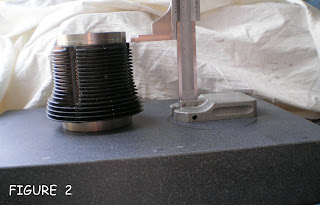
[AirVW] Re: Oil pump leak
Wed, 24 Nov 2004 05:48:06
--- In AirVW@yahoogroups.com, "Steve Chilcott"
> Bob was correct. When I checked the flatness of the full flow face
> plate I discovered there was a cupped sort of channel across the face
---------------------------------------------------
Well, good for me, then :-)
Of course, I was probably out back sawing up stove wood while the Mechanic-in-Charge of Steve's engine was doing all the work so let's give credit where due, which is to Steve.
There's lots of ways to check for flatness. One is to bridge the part with a known-true straight-edge such as the blade of your machinist's combination square then hold the part so you can see if there's any light between it and the straight-edge. For something like the cover-plate on the oil pump, that would serve as a quick & dirty check.
A better check would be to use a surface plate and some Prussian Blue. You smear the blueing onto the plate with your thumb, drop the cover-plate in the mess you just made and give it a light twist. If it's truly flat the blue will transfer to the entire plate.
Surface plate is a big piece of cast iron or a thick slab of granite. Cast iron surface plates are kinda rare nowadays bu
 (Fig 1 is an 8 x 10 high-precision surface plate used for setting-up cutting tools.)
(Fig 1 is an 8 x 10 high-precision surface plate used for setting-up cutting tools.)While cast iron surface plates were inexpensive and not all that difficult to make, they did change their dimensions with the seasons due to the expansion & contraction of the metal.
Granite was more accurate over the long term but flatting a hunk of granite took the task out of the machine shop. Which isn't to say you can't flat granite, just that it isn't a commonly taught skill. Unless you're into optics.
Nowadays you can buy a small surface plate for a very reasonable price but if you're only building one engine there are a number of substitutes that will fill the bill. The one most commonly available is a twelve-inch square of polished granite tile, available from Home Depot. To make it useful, get a piece of well dried 3/4" plywood, seal it up good with thinned varnish and after that cures, bed the tile in a layer of urethane painter's caulk. To ensure the caulking will cure, give the back of the tile a spritz of water before smooshing it into the caulking. Once it cures, the caulk will act as an elastomere, isolating the granite from the wood. (Fig 3. is an inexpensive 9 x 12 surface plate used for flatting, checking valve springs and other low-precision chores.)

Prussian Blue is the other head-scratcher for non-machinists, in that most of you won't know where to get it and will find it rather pricey for just one engine. So use lip stick. Yeah, they always look at me when I say that. Forget it. Go down to the Dollar Store or whatever and look for inexpensive cosmetics. Color isn't important. I generally look for stuff on sale, buy a couple of tubes of whatever.
Prussian Blue (or lip stick) serves as your 'spotting compound' when checking the fit of your valves after being lapped, and of the cylinder barrels in their bores and if the top edge of the barrels is true and the mesh of your cam-gear and lots of other stuff. Lipstick also cleans up nice.
Steve's experience with his leaky pump is a nice example why you can't just bolt parts together and expect to end up with a good engine. The fact it runs is not the definitive test. Virtually any collection of VW parts will run.
The tricky bit -- and the enormous mass of detail not contained in all those swell manuals telling you how to bolt things together -- is what to do to correct the numerous problems that crop up along the way, such as the drips or a tight bearing (or a loose one), valve gears that don't mesh proper or cock-eyed valve train geometry.
Experienced engine builders have found the best solution is to not let such errors occur. To prevent them, they blueprint all of the parts first as individual components then as sub-assemblies, mating them with their associated parts in as many pre-assembly steps as it takes, correcting errors as they are discovered.
This method is an absolute necessity when you have only one engines-worth of parts to work with.
-R.S.Hoover


No comments:
Post a Comment